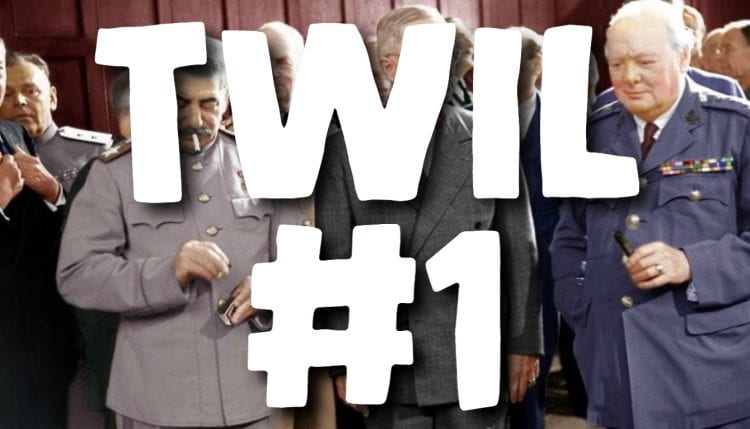
From Inverness To Berlin
Right from the beginning of our studies on Shakespeare’s Macbeth and the 1950s, the underlying theme of ‘Appearance vs. Reality’ has been abundantly clear in both these topics. Making connections between Macbeth’s thickening plot and the rising global tensions of the 50s seems almost too easy.

As of right now, we have completed reading and studying Act 1 of Macbeth, and so much has already taken place. I am still very new to Shakespeare however, and having to first decipher what is being said before having to decrypt the overall message of the script is certainly quite the challenge, and takes more brainpower than normal reading. Although his writing is difficult to read, I must say that there truly is something very special about reading Shakespeare. As I mentioned in my ‘Why Shakespeare?’ essay which you can find below, there really hasn’t been anybody who better encapsulates the beautiful nuances of humanity quite like our man Bill.
:max_bytes(150000):strip_icc()/GettyImages-170644277-5b8d6ae44cedfd00251d660c.jpg)
In terms of our learning on the 50s, we’ve actually done more learning on the late 40s! Post-war Europe is a critical time in world history and there was so much going on. We started off by discussing the Big 3 – Churchill, Roosevelt, and Stalin – and how they were meeting towards the end of the war as they knew their victory was imminent. At the first of their conferences, in Yalta, they agreed on various plans that would later come back to bite them in the ass. A few months down the line, they met again outside Berlin in Potsdam. This time however the Big 3 had been two thirds changed, following the death of Roosevelt and the parliamentary succession of Churchill. This much less cordial trio formed the United Nations and decided the security council featuring Russia, France, the US, and the UK. They then put Germany to work as well as putting Nazi high-commands on trial, resulting in the death of the majority of them. Tensions in Europe were really starting to rise.

Following this however, the US and Russia’s ever-growing distrust finally boiled over and with the threat of Stalin’s expanding communist society, the US announced they were in a cold war. As part of a plan to combat communism, the US spent $13 billion repairing Europe, while Stalin is tightening his grasp on the Soviet Union. As Germany is being rebuilt, the first international crisis of the cold war takes place as Stalin traps West Germany’s 2.1 million inhabitants in a chess move against the Allies. However, the US devised a plan to airdrop food and supplies in to the city for 11 months, and it worked.
/cdn.vox-cdn.com/uploads/chorus_image/image/51519253/GettyImages-541038943.0.jpg)
A few years later in 1949, the NATO treaty is signed, combining 12 countries in to allegiance to fight off what are predominantly communist threats. Communism is the biggest problem for the US at this time, and there was a genuine worry that Stalin would continue to take over Europe and more. Things only got worse when China fell to communist rule and the soviets exploded their first atomic bomb. This brings us to 1955, when the Warsaw Pact is signed, forming an allegiance between 7 Soviet states.

In less than ten years, Russia and the United States went from being allies to enemies. One might wonder how this is possible. Maybe it was a single even that split the two nations on different sides? Perhaps something someone said? The reality is, these two countries were never as close as they seemed. In between the conferences and media coverage, the Soviet Union and the US did not trust each other for a second. This is very similar to the plot of Macbeth, where Macbeth and his wife have plans to kill King Duncan, but act like his best friend. King Duncan is completely unsuspecting, and ironically feels as though he himself has a great nose for sniffing out the truth in people.

Even without the guidance of our driving question: “Using Shakespeare’s “Macbeth” and the history of the 1950’s, how can we use film to explore the theme of appearance vs. reality, and comment on what’s changed and what’s stayed the same?”, it is easy to see how this story and the historical relationships of the Cold War are similar. As the viewer, getting to look back on the entire picture of these stories gives us a unique perspective. We get to see things from all angles, and sometimes it seems blindingly obvious that the appearance doesn’t match the reality, but that’s what’s so special about analyzing them.
This week I learnt a lot. It was a great foundation for me to base the rest of my learning off of. I have found myself most intrigued by the historical events of the Cold War (as I’m sure you can tell!), and I look forward to seeing how story of both Macbeth and the 1950s play out.
For this weeks creative artifact I chose to make an image that represents the United States relationship with the Soviet Union in a funny and comical way. When I was younger I loved Spy vs. Spy, a comic series featuring the two spy characters shown below. I felt like their relationship symbolizes the US and USSR’s so I took an image of the two spies infamous pose and edited it in Superimpose.
